[Ten years since the Great East Japan Earthquake Vol.3] From the disaster-stricken Tohoku region to developing countries: Conveying knowledge of reconstruction and disaster risk reduction
2021.03.11
This is the final installment of a three-part series on JICA's cooperation for reconstruction and disaster risk reduction in developing countries. In this installment, we introduce Knowledge Co-Creation Program from the disaster-stricken Tohoku region in northeast Japan to share knowledge on disaster risk reduction and reconstruction with people in developing nations. The participants who returned to their countries are now applying the knowledge they learned back home.
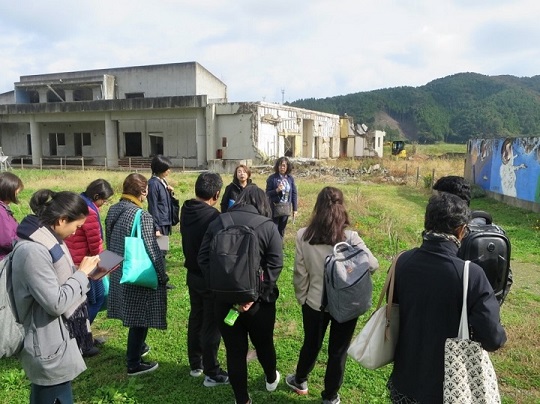
Participants listening to a storyteller talk about emergency evacuation and its challenges from the local residents’ perspective
A M Nasir Uddin, Manager of ActionAid Bangladesh (AAB), a Bangladeshi NGO, recalls, “I will never forget the sight of a man I met when I visited Ishinomaki. He was in tears every day, remembering his wife, who he lost in the earthquake. Through this program, I strongly felt that I want to do whatever I can to reduce such people’s grief around the world by communicating the risks of disasters in normal times.”
In 2017, Mr. Uddin participated in a program on disaster risk reduction from a gender and diversity perspective. The objective of the program was to learn about caring for the needs of people at high risk of being vulnerable during disasters, such as women and the elderly, and incorporating these needs into disaster risk reduction and recovery.
Based on the insights gained from the program, Mr. Uddin is now working as a disaster prevention manager at AAB, promoting efforts to communicate to women and other people living in poor areas about the risks of disasters. He has advised the government of Bangladesh to include women’s and girls’ perspectives during periods of calm and in disaster preparedness. He has also been encouraging women’s participation in various disaster-related support meetings, the number of which is gradually increasing.
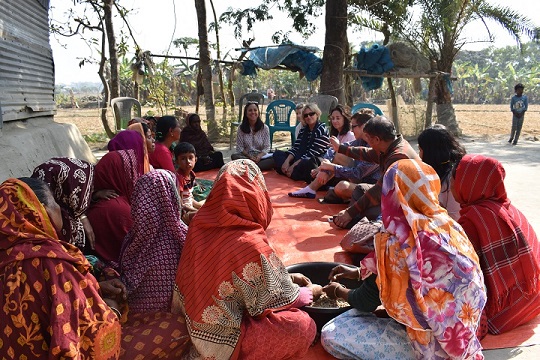
Mr. Uddin (the man in the center on the right) speaks to women about the risks of disasters
ISAWA Hitomi, a JICA Tohoku program officer in charge of planning this program, which has been held since 2015, speaks about the significance of the training, saying, “In the past, people had the perception that disaster risk reduction and response was support provided to women and undertaken by men. However, there is a growing awareness that disaster management and reconstruction should not be the sole responsibility of men but should be undertaken by a diverse range of people from all walks of life, not to mention women. Through this program held in the disaster-stricken area of Tohoku, I feel that the leadership and awareness of these issues are being conveyed.”
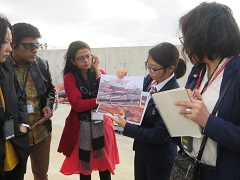
In the program in 2019, a young storyteller explains the current state of reconstruction and youth leadership
Looking back on the exchange of opinions between the participants and disaster victims, Ms. Isawa commented, “I heard many of the participants saying, ‘Based on past disaster experiences, people in Japan are accustomed to thinking about how they should live their daily lives and make improvements as needed so that they can cope with emergencies,’ and, ‘I realized what the term, Build Back Better, really means, only after I came to Japan.’ I think the disaster victims were also given encouragement by knowing that there were people around the world who were engaged in disaster risk reduction with the same spirit.”
So far, 78 individuals (50 women and 28 men) from a total of 17 countries in Asia, Latin America, and other regions have participated in this program, including officials from women-related ministries, disaster management-related ministries, and civil society organizations.
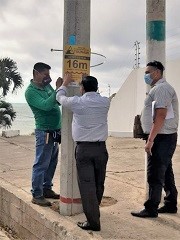
Tsunami inundation height signs are being installed in Sucre, thanks to the efforts of Mr. Chica
“Sucre, where I live, faces the sea, but it did not have its own earthquake and tsunami evacuation plan. After receiving program in Tohoku, I thought the city needed to have one. I started to develop an evacuation plan for the city upon my return from Japan.”
Speaking about the initiative in his own country is Jesús Javier Alcívar Chica from Ecuador, South America, who participated in the 2019 “Disaster Reconstruction Assistance” program. He works as a risk technician in Risk and International Cooperation department of Sucre city.
This program was initiated in 2018 for participants to learn the roles of government agencies in the recovery and reconstruction period from natural disasters. It also includes program on the consensus-building process between citizens and government in the formulation of reconstruction plans, including community relocation and land use. The program has been held three times so far, with 29 participants from a total of 12 countries.
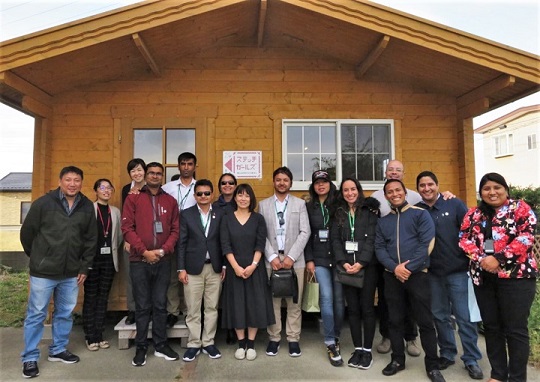
Participants in 2019. They addressed reconstruction issues from the government’s standpoint (third from right is Mr. Chica)
During an exchange with the victims of the Great East Japan Earthquake at a relocation site in Iwanuma city, Miyagi Prefecture, Ms. Rojas Angel Jeniffer Abril, a participant from Mexico (working for the National Interagency Coordination of Civil Protection of the Government of Mexico), sat on her knees, bowed deeply, and expressed her gratitude for the program with tears in her eyes. She expressed her respect for the people who were overcoming the disaster, and voiced her determination to work on community-based reconstruction and disaster mitigation when she returns to her home country. “As a government official, I will stay close to the disaster victims and residents, and engage in dialogue with them.” She is now promoting disaster-resistant urban development in Mexico.
JICA Tohoku, based in Sendai, has been working on disaster recovery and disaster risk reduction through various initiatives. In 2011, when an earthquake hit the region, it swiftly deployed regional reconstruction coordinators, and in the following year, it began holding seminars and programs related to reconstruction. Today, it continues to disseminate the knowledge of Tohoku reconstruction and disaster risk reduction to the world through its many activities.
Reflecting on the past 10 years and looking ahead towards the future, SATO Ichiro, deputy director general of JICA Tohoku, says, ”The programs in Tohoku have provided valuable opportunities for participants to learn from experience of those who have directly been involved in reconstruction and disaster risk reduction. The reconstruction of the disaster-affected areas is not over yet. From now on, there will be an increasing need to tackle issues common to rural areas in tandem with reconstruction and disaster-resistant urban development. This includes decarbonization of society, revitalization of the local economy, and measures to cope with the declining birthrate and aging population. Additional initiatives like these are underway in different parts of Tohoku, and we hope to continue to share the experience and know-how with the developing countries.
scroll